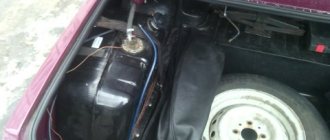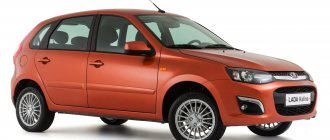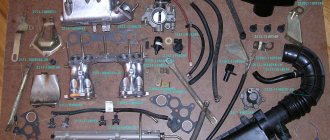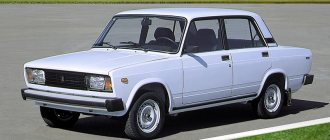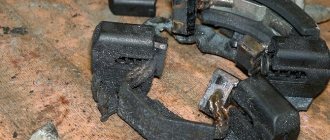Main characteristics of the model
In the large model range of Zhiguli cars, the VAZ-21074 stands apart. A powerful engine with a displacement of 1569 cm 3 gave it the right at that time to be considered the fastest rear-wheel drive sedan that rolled off the assembly line of the Volzhsky Automobile Plant.
On the first models of the 7th series, the engine was similar to the 5th model. Only a little later they began to install a more powerful engine from the no less popular VAZ-2106 car.
The vehicle's ground clearance is 17.5 cm. The installed tires have an outer radius of 165 mm. The volume of the luggage compartment is 355 liters. The total curb weight of the vehicle is 1430 kg. Maximum speed is 150 km/h. In 16 seconds the car accelerates to hundreds. A fuel tank of 39 liters allows you to store a fuel reserve of 400 km in urban mode.
The brake system did not change and was inherited from the prototype model - VAZ 2105. Initially, these cars were almost identical, but, nevertheless, they had certain distinctive features, namely:
- shape of the hood and trunk;
- radiator screen;
- rear lights;
- chrome bumper trims.
The car has proven itself to be unpretentious in operation, and the cost of spare parts is in an affordable price segment. This aspect is one of the main factors that positively influences the buyer’s choice (in favor of the VAZ-21074). We will consider the technical characteristics of components and assemblies in more detail below.
Vehicle specifications
The VAZ 21074 is made in a sedan body - both in the opinion of the plant’s designers and in the opinion of car enthusiasts, a sedan is the most convenient “box” for both personal use and for cargo transportation.
It is worth noting that the carrying capacity of the machine indicated in the technical documents (1430 kg) is underestimated. Surely you have more than once seen a “four” loaded to maximum, on which neighbors were transporting things or bags of potatoes. Until now, in any market, a fairly large number of sellers use the VAZ 21074 to transport goods. Do not forget that initially the model was not created for the transportation of goods in principle!
The carburetor mechanism in the VAZ 21074 is two-chamber, emulsion
Salon VAZ-21074
The design of all modifications of the VAZ-2107 family (including the VAZ-21074 injector) provides for the arrangement of components and assemblies according to the so-called classical scheme, when the rear wheels are driven and the engine is shifted forward as much as possible, thereby ensuring optimal weight distribution along the axles and, as a result, improving vehicle stability. Thanks to this arrangement of the power unit, the interior turned out to be quite spacious and was located inside the wheelbase, i.e., in the zone of best ride smoothness, which could not but affect the comfort of the car.
The interior of the VAZ-21074 turned out to be quite spacious and comfortable
The interior trim is made of high-quality non-glare materials. The floor is covered with mats made of non-woven material on a polypropylene base. The body pillars and doors are upholstered in semi-rigid plastic, covered on the front side with caprovelor; velutin is used for seat upholstery. The ceiling is finished with polyvinyl chloride film with a duplicated foam pad, glued to a base formed from plastic. Through the use of various mastics, layered bitumen gaskets and felt inserts:
- heat and sound insulation of the interior is achieved;
- vibration is eliminated;
- Metal components are protected from corrosion.
Engine and transmission
The engine from the VAZ-2106 was installed on the VAZ-21074 model without any modifications. The technical characteristics of the engine made it possible to achieve a power of 74 hp. With. There are 2 valves per cylinder. The “five” had a belt drive of the camshaft, which made the engine less noisy. However, a belt is less reliable than a chain. Therefore, on a more powerful engine, it was decided to leave the timing chain transmission unchanged.
The gearbox compares favorably with its predecessors. It has a fifth speed, the gear ratio of which is 0.819. All other speeds have lower gear ratios compared to previous analogues. As a result, the gearbox operates more “softly”. The rear axle gearbox with self-locking differentials has 22 splines - it was borrowed from the VAZ-2106 model.
The suspension of the front pair of wheels is independent. The rear suspension has a rigid beam. This design significantly improved the car's stability when cornering.
Transmission
| Clutch | single-disk, dry, with hydraulic shutdown drive and central diaphragm spring | |||
| Transmission | mechanical, four- or five-speed, three-way, three-shaft, with synchronizers on all forward gears | |||
| Gear ratios: | ||||
| first | 3,67 | |||
| second | 2,10 | |||
| third | 1,36 | |||
| fourth | 1,0 | |||
| fifth | 0,82 | |||
| reverse | 3,53 | |||
| Cardan transmission | two-shaft, with intermediate support and elastic coupling | |||
| main gear | hypoid | |||
| Final drive ratio | gear ratio - 3.9 or 4.1 | |||
| Differential | conical, two-satellite | |||
Design and construction
Compared to the basic “five”, the luxury version of the VAZ-2107 received a new and even daring front design, a different radiator grille, which was most often chrome-plated, plastic bumpers with chrome trims. To accommodate the new radiator grille with a larger area, the shape of the hood had to be changed. Less noticeable changes include slightly modified rear lights and a modified shape of the trunk lid; compared to the VAZ-2105, there were no stampings on it, but since 2008, due to unification, the shape of the lid has become the same as that of the “five”.
In the interior of the VAZ-2107, more comfortable front seats with integrated headrests were installed, and even more comfortable than those installed on some more modern VAZ-produced cars. For the first time, the rear sofa received a folding center armrest. Cold air deflectors appeared in the center of the dashboard, and a tachometer and oil pressure indicator appeared on the instrument panel. A new 4-spoke steering wheel was developed especially for the VAZ-2107. Some other interior details were also changed - door trim, beard, door lock buttons and gear shift lever.
As a power unit, the VAZ-2107 car received a more powerful 8-valve carburetor engine with a volume of 1.5 liters and a power of 77 horsepower, together with a manual 4-speed gearbox. But as expected, this engine was not the only one equipped with the VAZ-2107. By analogy with its predecessors, the “Seven” was equipped with a variety of engines with a volume of 1.3 to 1.7 liters and a power of 64 to 140 horsepower (with a rotary piston engine).
Since about the beginning of the 2000s, the VAZ-2107, along with other cars of the classic family, has increasingly been subject to tuning. Its low cost on the one hand and simply an incredible number of shortcomings on the other greatly contributed to this. Very often, the car was subjected to additional sound insulation, modifications to the engine to increase its power, and increase the overall level of comfort. This list can be continued endlessly.
Description of the salon
By modern standards, the exterior of the VAZ 21074 is outdated.
It’s difficult to talk about the appearance, because in fact the car is very outdated and looks like a rarity in the city. But in any case, from a certain angle, we can say that it doesn’t seem to be scary. In a word, classicism.
Andreyka
https://www.avtodor.su/articles-avtomobil-vaz-21074
Due to the fact that the entire line of the VAZ 2107 family (and the VAZ 21074 is no exception here) is rear-wheel drive, the engine is located in front, which made it possible to significantly expand the interior space: both in the ceiling and in the legs for the driver and front row passenger.
Compared to previous versions of the VAZ, the 21074 is more spacious inside
The interior trim is made of special plastic alloys that do not give glare and are easy to maintain. The floor of the car is covered with polypropylene mats. The body pillars and the inner parts of the doors are covered with medium-hard plastic and covered with caprovelor on top. The seats in most cars are upholstered in durable, wear-resistant fabric - velutine.
It must also be said that the VAZ 21074 uses a large number of “auxiliary” materials for interior decoration - various types of mastics, bitumen gaskets, felt pads and lines. All these materials come into contact with the upholstery in one way or another (doors, bottom, seats) and protect the interior from excessive noise from the outside. Bitumen and mastic are used primarily in vehicle underbody equipment, while soft and textile materials are used in upholstery and trim. This equipment not only helps make a person’s stay in the cabin more comfortable, but also solves a number of other problems:
- increased cabin sound insulation;
- minimizing vibration waves while driving;
- protection of metal from rust;
- increasing the thermal insulation of the cabin.
High-quality plastic and durable velutine fabric are used to equip the interior.
Dashboard
VAZ 21074 is considered a more comfortable version of the VAZ 2107. Comfort is achieved in various ways, including making it easier to drive. Thus, the instrument panel allows the driver to see current data on both the ride and the condition of his “iron horse” at any time.
On the VAZ 21074, the dashboard is made up of many elements, each of which shows the operation of a particular unit in the car. The panel is embedded in the dashboard of the car on the driver's side. All elements are located under plastic glass: on the one hand, they are clearly visible, on the other, the devices will be protected from possible mechanical shocks.
The instrument panel is protected from external influences by a plastic visor and durable glass
The instrument panel of the VAZ 21074 contains the following elements:
- A speedometer is a special mechanism that shows the current speed. The scale is numbered in divisions from 0 to 180, where each division is the speed in kilometers per hour.
- Tachometer - located to the left of the speedometer and is used so that the driver can see the crankshaft rotation speed per minute.
- ECON fuel consumption gauge.
- Engine temperature indicator - for the VAZ 21074, the engine operating temperature is set in the range of 91–95 degrees. If the pointer needle “crawls” into the red zone of the device, the power unit is working at the limit of its capabilities.
- Fuel quantity indicator in the gas tank.
- Accumulator charging. If the battery light comes on, it is necessary to provide additional charging to the battery (the battery is discharged).
In addition, there are additional lights and indicators on the instrument panel that remain turned off during normal operation (for example, engine oil level, engine problems, high beam, etc.). The lights turn on only when there is a problem with a particular system or when a certain option is enabled.
Illuminated additional elements indicate errors, problems or the inclusion of an option
Gear shift diagram
The gearbox on the VAZ 21074 operates according to the international standard. That is, the first four gears are switched on by analogy with the writing of the Russian letter “I”: up, down, up, down, and the fifth - to the right and forward. Reverse speed is switched to the right and backward.
Video: universal speed shifting
Some questions among drivers are controversial. For example, when is it better to change gears in a car:
don’t pay attention to the rpm, look at the speed, the first one starts, the second one is up to 40, the third is at least up to 80 (the consumption will be high, better than 60), then the fourth, if the hill is ahead and you have 60 and the fourth, then it’s better to go to a lower speed select only when switching (at the moment the clutch pedal is released), so that it is smooth, without jerking, and in general the marks are already made on the speedometer) when you need to switch
Gear shifting on the VAZ 21074 is carried out in the same way as on modern cars according to the international standard for manual transmission
The VAZ 21074 car is still actively used by car enthusiasts today. Despite the outdated design and limited functionality (compared to modern standards), the machine is very reliable and durable. In addition, the simplicity of the design allows you to fix all breakdowns yourself and not spend money on expensive service services.
Technical characteristics of Lada (VAZ) 21074
The VAZ-2107 sedan is the most comfortable model of rear-wheel drive VAZ cars. The car is distinguished by original anatomical front seats with a high back, a more modern instrument panel with a tachometer, and an original radiator grille. In general, the VAZ-2107 can rightfully be called the most advanced and comfortable rear-wheel drive domestic sedan.
The automobile catalog contains a description, technical characteristics and photographs of the Lada (VAZ) 21074 car.
Salon
Among all the classic Zhiguli models, the interior of the VAZ-21074 is the most comfortable and modern. The front seats compare favorably with their predecessors - sitting in them is much more comfortable. Anatomical seats without headrests are a distinctive feature of the “Seven”.
Improved interior trim with higher quality materials and modern seat upholstery have allowed the VAZ-21074 to occupy a leading position in the domestic car market for many years.
In general, the VAZ-21074, the technical characteristics of which were disclosed in this article, deserves respect and trust from car enthusiasts. The affordable cost of both the car and spare parts was appreciated by consumers. This is confirmed by the popularity of the car, which continues to this day.
Total information
ParametersVAZ 2107VAZ 21074VAZ 2107-20VAZ 21074-20
| Weight of the equipped vehicle, kg | 1060 | 1060 | 1060 | 1060 |
| Payload, kg | 400 | 400 | 400 | 400 |
| Permitted maximum weight, kg | 1460 | 1460 | 1460 | 1460 |
| Ground clearance of a vehicle with a permissible maximum weight, with tires 175/70 R13, not less, mm: | ||||
| to the front suspension cross member | 162 | 162 | 162 | 159 |
| to the rear axle beam | 157 | 157 | 157 | 154 |
| Permissible weight of cargo on the additional (top) luggage rack, kg | 50 | 50 | 50 | 50 |
| Maximum speed, km/h: | ||||
| with permissible maximum weight | 148 | 148 | — | — |
| with driver and passenger | 150 | 150 | 150 | 150 |
| Acceleration time from standstill to 100 km/h, s: | ||||
| with driver and one passenger | 17 | 16 | 17 | 16 |
| with permissible maximum weight | 19 | 17,5 | — | — |
| Minimum turning radius along the track of the outer front wheel, m | 5,6 | 5,6 | 5,6 | 5,6 |
| The greatest rise overcome by a car with a permissible maximum weight without acceleration in first gear, % | 36 | 36 | 36 | 36 |
RњРѕС‚РѕСЂ Р'РђР— 2107
РќР° Р'РђР - 2107 СЃ 1982 РіРѕРґР° устанавливались инжекторные карбю раторные двигатели объемом РѕС‚ 1.3 РґРѕ 1.7 литров. Силовой агрегат представляет SЃРѕР±РѕР№ доработанную Рј RѕРґРёС„Рекацию R'РђР— 2105. Р'СЃРµ RґРІРёРіР°С ‚ели Р'РђР— 2107 отличаются простым обслуживанием, кото СЂРѕРµ желательно РїСЂРѕРёР ·РІРѕРґРёС‚СЊ каждые 10 тысяч RєРёР»РѕРјРµС‚СЂРѕРІ. RR»СЏ обслужРеваннкарбюраторов допустимо кппльзовать полусинтетику, Р° РёРЅР¶РµРєС‚РѕСЂРЅС ‹Рµ модели нуждаются РІ S…орошем RјРѕС‚РѕСЂРЅРѕРј SЃРёРЅС‚етическом масле.
ХарактеристРеРєР° автомобиля 2107
- Габариты Длина: 4145 РјРјРЁРёСЂРёРЅР°: 1620 РјРјР'ысота: 1435 ммКолесная R ±Р°Р·Р°: 2424РљРѕР» ея передняя: 1365Колея задняя: 1321Клиренс: 170 ммОбъем багажника максимальный: 325 лСРнаряженна Cџ RAR ° Сѓsѓr ° p ° ° ° РРѕР ± rut ± Сџ Сџ: 1060 rrir "rhrїsѓs ° ° Сџ РїРѕР ѕ ° Сџ ° ° Сѓ ° °: 1460 r.
- R”иаметр разворота: 9.9 Rј
R'RµSЂSЃРёРё моторов RєР°СЂР±СЋСЂР°С‚РѕСЂРЅРѕРіРѕ S‚РеРїР° Ремеют RјР°СЂРєРёСЂРѕР ІРєСѓ 2103 Ryo 2106. Основные неисправности SЃРІСЏР·Р°РЅС‹ СЃ плаваюS ‰РёРјРё оборотамммотора, троением перегревом. R'R»Р°РіРѕРґР°СЂСЏ простой конструкцРеРё SЂРµРјРѕРЅС‚ SЃРёР»РѕРІРѕРіРѕ Р°РіС ЂРµРіР°С‚Р° достаточно легкий.
Rнжекторные RІР°СЂРёР°Рты дввгателя R'РђР— 2107 считаются более SЃРѕРІСЂРµРјРµРЅРЅС‹РјРё.
Р' Р'РђР— 2107 воздушно-топливная SЃРјРµСЃСЊ РІ цилиндрах РїРѕР»СѓС‡Р°РµС ‚СЃСЏ благодаря SЃРёСЃС‚ еме раздельного впрыска. R' инжекторе 4 форсунки, RєРѕС‚орые SѓРїСЂР°РІР»СЏСЋС‚СЃСЏ RјРёРєСЂР ѕРєРѕРЅС‚роллером.
RџРѕСЃС‚упление S‚оплива SЂРµРіСѓР»РћСЂСѓРµС‚СЃСЏ РІ R·R°РІРЃРёРјРѕСЃС‚Рё РѕС R° RІС‚омобиля.
РљРџР» инжекторного двигателя Р'РђР— 2107 выше, чем РєР°СЂР±СЋСЂР°С ‚РѕСЂРЅРѕРіРѕ.
R”вигатель SѓСЃС‚РѕР№С‡РеРІ Rє S…олостому S…РѕРґСѓ Ryo SЂРµРґРєРѕ RіР»РѕС…РЅРµС ‚ РїСЂРё старте СЃ места Р± R»Р°РіРѕРґР°СЂСЏ продуманной электронике.
Мотор обладает РЅРѕР·РєРёРј шумом благодаря R°РІС‚оматМмесРєРѕР№ регулировке натяжения S†РµРїРё.
ТехническРеРµ S…арактеристРеРєРё
Рљ недостаткам двигателя относится его расположеРЅРѕРµ РїРѕРґ капотом, огранп‡РёРІР°СЋС‰РµРµ доступ Рє его деталям РїСЂРё необходРемости. ввигатель отличается высокой требовательностьS Ћ Рє качеству S‚опливР° Рё масла. Самостоятельная диагностика силового агрегата РїСЂ Рё неисправностях затруднена без специального оборудования. R”R”SЏ SЂRµRјRѕРЅС‚Р° R’RђR— 2107 RїSЂРёРґРµС‚СЃСЏ RѕR±SЂR°S‚иться RSR° SЃС‚анцию S‚Р µС…обслуживания.
R r°sѓs…rѕrґs‚рѕрїр»ррѓр°
- расход топлива РІ РіРѕСЂРѕРґСЃРєРєРёС… условвЏх составляет 9.4 Р» РЅР ° 100 РєРј.
- РџРѕ СЂРѕРІРЅРѕР№ РґРѕСЂРѕРіРµ РЅР° крейсерской скорости РѕРЅ будет С ЃРѕСЃС‚авлять уже 6.9 R»РёС‚СЂРѕРІ РЅР° 100 RєРј пути.
- R' SЃРјРµС€Р°РЅРЅРѕРј SЂРµР¶РёРјРµ SЂР°СЃС…РѕРґ будет SЃРѕСЃС‚авлять РѕС‚ 8 РґРѕ 9 Р» итров РЅР° 100 РєРј. Такие цифры РЅРµ позволяют назвать этот RјРѕС‚РѕСЂ СЌРєРѕРЅР ѕРјРёС‡РЅС‹Рј, RѕРґРЅР°РєРѕ РІ данном SЃР»СѓС‡Р °Рµ РјРЅРѕРіРѕРµ заввисит как раз РѕС‚ самого водителя.
- ЕщС' РѕРґРёРЅ параметр, который заввисит РѕС‚ водителя, это расход масла РЅР ° 100 РєРј. RR»СЏ SЃSЂRµРґРЅРµСЃС‚атистического водителя R°РІС‚омобиля СЃ данным мотором РѕРЅ составляет 700 RіСЂ РЅР° 100 РєРј. RS‚Рѕ, конечно, РЅРµ RјР°Р»Рѕ, РЅРѕ РїСЂРё R°РєРєСѓСЂР°С‚РЅРѕР№ езде RјРѕР¶РЅРѕ SѓРјР µРЅСЊС€РёС‚СЊ этот расход вплоть RґРѕ 450-500 RіСт./100 RєРј.
- Р'ес двигателя 2103 РІ полностью SЃРѕР±СЂР°РхРЅРѕРј SЃРѕСЃС‚РѕСЏРЅРёРё СЃР ѕСЃС‚авляет 121 РєРі.
RћRїРёСЃР°РЅРёРµ RєРѕРЅСЃС‚СЂСѓРєС†РеРё
RѕRїРёСЃР°РЅРеРµ RєРѕРЅСЃС‚СЂСѓРєС†РеРё двигателя ваз 2107
Р' зависРемости РѕС‚ модификации РЅР° автомобиль ваз 2107 може S‚ быть SѓСЃС‚ановР"ен РѕРґРёРЅ РёР· четырех РґРІРІріР°С‚елей: 2103, 2104 (объемом 1.5 Р") или 2106, 21067 (объемом 1.6 Р» ).
R»РІРёРіР°С‚ель автомобиля ваз 2107
— бензиновый, четырехтактный, четырехцРелиндровый, СЂСЏРґРыР№, восьмиклапанный, СЃ верхним расположением распределительного вала. ввигатели 2103 Рё 2106 — карбюраторные, Р° двигатели 2104 Рё 21067 — СЃ SЂР°СЃРїСЂРµРґРµР»РµРЅРЅС‹Рј РІРїСЂС‹ SЃРєРѕРј S‚оплива.
ввигатель 2104 создан РЅР° базе дввггателя 2103, поэтому блок С †РеР»РеРЅРґСЂРѕРІ, шатунно-поршневая РіСЂСѓРїРїР°, РїСЂРёРІРѕРґ газораспределител SЊРЅРѕРіРѕ механизма Рё коленчатый РІР° R» имеют одинаковую RєРѕРЅСЃС‚рукцию Рё размеры.
ввигатель 21067 создан на базе дввггателя 2106.
Так как двигатели 21067 Рё 2104 имеют разРые диаметры цилинРґСЂРѕРІ, то Рё поршни SЃ кольцами соответственно РЅРµ взаммозаменяемы.
Детали РїСЂРеРІРѕРґР° газораспределительного RјРµС…анизма Рё РєР ѕР»РµРЅС‡Р°С‚ые валы SЌS‚РёС… двигателей идентичРСС‹.
РќР° крышке РїСЂРеРІРѕРґР° распределительного вала РёРЅР¶РµРєС‚РѕС ЂРЅС‹С… РґРІРегателей выполнены кроншт ейны для установки датчика RїРѕР»РѕР¶РµРЅРЅРєРѕР»РµРЅС‡Р°С‚РѕРіРѕ вала.
ввигатели автомобилей ваз 2107, оснащенные SЃРёСЃС‚емой РІР їСЂС‹СЃРєР°, соответствуют РЅРѕСЂРјР °Рј токсичности отработавших газов Р•Р'Р Рћ II.
Chassis, steering and braking system
The front suspension of the VAZ 2107 has an independent double wishbone design with two shock absorbers and springs, as well as a stabilizer bar. The rear suspension is dependent with a rigid beam, which is connected to the body through one transverse and 4 longitudinal reaction rods. The suspension design is complemented by two hydraulic shock absorbers with coil springs.
wheels - 5Jxl3H2 (permissible offset 25-30 mm);
tires - 175/70R13 (165/70R13).
The steering mechanism of the VAZ 2107 is a globoidal “worm” driven by a double-ridge roller (gear ratio 16.4). Drive – three-link (2 lateral symmetrical rods, middle symmetrical rod, pendulum arm, swing arm, bipod).
The VAZ 2107 brake system has a foot (foot) drive through a vacuum booster. Its design also includes an emergency sensor and a brake fluid pressure regulator in the rear wheel drive. The parking (hand) brake is activated by a cable that engages the rear wheel chocks. The rear wheels are equipped with a drum-type brake mechanism.
The brake mechanism of the front wheels has a classic disc design with automatic clearance adjustment.
Brake system
| Service brake system: | ||||
| front wheel brake | disc, with two-piston caliper | |||
| rear wheel brake | drum, with one working cylinder and two pistons | |||
| Service brake system drive | foot, hydraulic, dual-circuit, with a vacuum booster, rear wheel brake pressure regulator and low brake fluid level sensor | |||
| Parking brake | with manual cable drive on the brake pads of the rear wheels | |||
Similar articles:
- Design and technical characteristics of the VAZ 2105 injector: dimensions, tank volume, fuel consumption
- Description of the device and technical characteristics of the VAZ 21074 injector, filling tanks, fuel consumption and other data
- Volkswagen Santana - review of the model range technical specifications tuning auto photos of the interior
- Design and technical characteristics of the VAZ 2105 injector dimensions tank volume fuel consumption
Carburetor
The first cars in the series had a carburetor installed in the VAZ-21074. The technical characteristics of an engine with this type of fuel injection were as follows:
- fuel type - AI-95;
- engine power - 75 hp. With.;
- torque - 116 Nm (at 3750 rpm);
- fuel consumption (city) - 9.7 l/100 km;
- fuel consumption (highway) - 7.3 l/100 km;
- Acceleration time to 100 km/h - 15 seconds.
On the model with a vacuum corrector, a DAAZ 2107-1107010-20 carburetor was installed. Over the years of operation, this unit has proven its reliability and durability. Despite this, the carburetor system is very sensitive to fuel quality. Therefore, the manufacturer began installing a modern injection system on models of later years of production.
VAZ 2107 Seven technical specifications
Modifications of VAZ 2107
LADA-2107 (engine 2103, 1.5 l, 8 cl., carburetor)
LADA-21072 (engine 2105, 1.3 l (1290 cm3), 8 cells, carburetor, timing belt drive)
LADA-21073 (engine 1.7 l (1689 cm3), 8 cells, mono injection - export version for the European market)
LADA-21074 (engine 2106, 1.6 l (1569 cm3), 8 cells, carburetor)
LADA-21070 (engine 2103, 1.5 l, 8 cl., carburetor)
LADA-2107-20 (engine 2104, 1.5 l, 8 cells, distributed injection, Euro-2)
LADA-2107-71 (engine 1.4 l, 66 hp engine 21034 for A-76 gasoline, version for China)
LADA-21074-20 (engine 21067-10, 1.6 l, 8 cells, distributed injection, Euro-2)
LADA-21074-30 (engine 21067-20, 1.6 l, 8 cells, distributed injection, Euro-3)
LADA-210740 (engine 21067, 1.6 l, 53 kW/72.7 hp 8 cells, injector, catalyst) (2007 onwards)
LADA-21075 (1.5 l engine, (1524 cm3 - 75 hp and 1524 cm3 - 65 hp), 1982 - 2012 onwards)
LADA-21077 (engine 2105, 1.3 l, 8 cl., carburetor, timing belt drive - export version for the UK)
LADA-21078 (engine 2106, 1.6 l, 8 cl., carburetor - export version for the UK)
LADA-21079 (rotary piston engine 1.3 l, 140 hp, originally created for the needs of the Ministry of Internal Affairs and the KGB)
LADA-2107 ZNG (engine 21213, 1.7 l, 8 cells, central injection)
Performance characteristics of the VAZ 2107 seven
Maximum speed: 155 km/h Fuel consumption per 100 km in the city: 8.9 l Gas tank volume: 39 l Curb weight of the vehicle: 1030 kg Permissible gross weight: 1430 kg Tire size: 175/70 SR13
Location: front, longitudinal Engine volume: 1450 cm3 Engine power: 71 hp Number of revolutions: 5600 Torque: 104/3400 N*m Power system: injector Turbocharging: no Gas distribution mechanism: OHC Cylinder arrangement: In-line Number of cylinders: 4 Cylinder diameter: 76 mm Piston stroke: 80 mm degree compression: 8.5 Number of valves per cylinder: 2 Recommended fuel: AI-92
Front brakes: Disc Rear brakes: Drum
Steering type: Worm gearPower steering: no
Drive: Rear Number of gears: manual gearbox – 5 Gear ratio of the main pair: 3.9
Front suspension: Double wishbone Rear suspension: Coil spring
Body type: sedan Number of doors: 4 Number of seats: 5 Car length: 4128 mm Car width: 1620 mm Car height: 1435 mm Wheelbase: 2424 mm Front track: 1365 mm Rear track: 1321 mm Ground clearance (clearance): 170 mm Trunk volume: 325 l
Year of manufacture: from 1982 to 2012
Dimensions of VAZ 2107
Injector
The first injection VAZ-21074 appeared only in 2006. Car enthusiasts were enthusiastic about the new product and preferred to buy cars with such an injection system.
Despite the fact that the cost of such a car was higher, the complexity of the equipment (the presence of a computer unit, a number of sensors) meant slightly higher operating costs, but at the same time a number of advantages appeared, namely:
- Lower fuel consumption compared to the carburetor model.
- Easy engine starting (especially in cold weather).
- The influence of fuel quality on the nature of engine operation was neutralized.
- Stable engine operation at idle speeds, which are much lower than those of carburetor models.
The installation of a modern injection system has opened up new opportunities for VAZ-21074 owners. The injector allows you to change the technical characteristics very quickly - reprogramming the control unit can make the engine more economical or, conversely, more powerful and responsive. There is no need to change the engine design in any way.
Operational features and popular love
There is no particular need to talk about any dynamic characteristics of the VAZ 21074 with a classic carburetor. Stock sevens could accelerate to hundreds in 16 seconds. During this time, a Volkswagen Golf of the same year of production could accelerate to 200 km/h, and a mid-range sports car could enter Earth orbit, but that was not why the seven was valued. And they appreciate it now.
They loved it for its unpretentiousness in repairs, ease of maintenance, and for the fact that in every village store you could buy at least a ball joint, a head gasket, or a carburetor repair kit. Moreover, all the repairs could be done with your own, even not very skillful, hands, and a good breakdown of a reliable Fiat engine happened extremely rarely, and even then due to the driver’s oversight. The Seven with the 2106 engine was loved for its timing chain drive. The fact is that on the five-wheel engines that were installed on version 21072, the timing drive was belt driven, which meant that if the belt breaks, bending of the valves and failure of the cylinder head is guaranteed unless pistons with special “five-point” grooves are installed. The engine made less noise, but was 3 horses weaker.
Review of the VAZ-21074 injector model
The beginning of serial production of VAZ-21074 cars dates back to 1982, when the first copies of this model rolled off the assembly line of the Volzhsky Automobile Plant. At that time, the car was equipped with a carburetor power system: the injector on the VAZ-21074 appeared only in 2006. The advantages of the injection method of fuel supply are no longer a revelation to anyone, and after this system was implemented on the VAZ-21074:
- the engine began to start better in conditions of negative temperatures, without requiring prolonged warm-up;
- at idle speed the engine began to operate more smoothly and quietly;
- fuel consumption has decreased.
The injection version of the VAZ-21074 replaced the carburetor version in 2006.
The disadvantages of the VAZ-21074 include:
- low location of the exhaust pipe catalyst, which increases the risk of damage to this expensive part;
- inaccessibility of some parts and sensors, which was a consequence of the fact that the old type of body was not designed for an injection system - in the carburetor version there is much more space under the hood;
- low level of noise insulation, which reduces the level of comfort of the car.
The presence of a computer control unit allows you to respond in a timely manner to the occurrence of malfunctions, since a signal about a breakdown is immediately sent to the instrument panel. The control circuit for the operation of the engine and its systems used in the VAZ-21074 allows you to control the composition of the fuel mixture, turn the fuel pump on and off using electronics, and continuously monitor all components and mechanisms.
The control circuit of the VAZ-21074 allows you to respond in a timely manner to malfunctions of systems and mechanisms
The control scheme includes:
- Motor diagnostic block;
- Tachometer;
- Control system fault monitoring lamp;
- Throttle sensor;
- Throttle valve;
- Radiator cooling fan;
- Fan relay;
- Control block;
- Ignition coil;
- Speed sensor;
- Ignition section;
- Temperature sensor;
- Crankshaft sensor;
- Fuel pump relay;
- Fuel tank;
- Gasoline pump;
- Bypass valve;
- Safety valve;
- Gravity valve;
- Fuel filter;
- Canister purge valve;
- Reception pipe;
- Oxygen sensor;
- Battery;
- Egnition lock;
- Main relay;
- Nozzle;
- Fuel pressure control;
- Idle air control;
- Air filter;
- Air flow sensor.
A plate with identification data of the VAZ-21074 car can be found on the bottom shelf of the air intake box, which is located under the hood near the windshield, closer to the passenger seat. Next to the plate (1) is stamped VIN (2) - the vehicle identification number.
The plate with the identification data of the VAZ-21074 car can be found on the bottom shelf of the air intake box
The passport data on the plate is:
- Parts number;
- Manufacturing plant;
- Indication of conformity and vehicle type approval number;
- An identification number;
- Power unit model;
- Maximum permissible force on the front axle;
- Maximum permissible load on the rear axle;
- Version and equipment;
- Maximum permitted vehicle weight;
- Maximum permitted weight with trailer.
The alphanumeric characters on the VIN number mean:
- the first three digits are the manufacturing plant code (in accordance with international standards);
- the next 6 digits are the VAZ model;
- Latin letter (or number) - year of manufacture of the model;
- the last 7 digits are the body number.
The VIN number can also be seen in the trunk on the left rear wheel arch connector.
The VIN number can also be seen in the trunk on the left rear wheel arch connector
I drove it for two years, and during that time I only changed consumables and one ball joint. But then one winter an emergency happened. I went to visit the village, and it was incredibly cold outside, about -35. While we were sitting at the table, a short circuit occurred and the wiring began to melt. It’s good that someone looked out the window and sounded the alarm, and they eliminated this incident with snow and hands. The car stopped driving and a tow truck brought it to the house. Having seen all the consequences in the garage, I thought that not everything was as scary as it seemed at first glance, although the wiring, all the sensors and some parts had to be disposed of. Well, in short, I decided to restore it and called a friend who was famous among his friends as a good mechanic. After a short search for spare parts, it became clear that it would be problematic to restore the injector, since not all of the required components were in stock, and the price tag for them was outrageous. As a result, we threw out the idea of fixing the injector, deciding to make a carburetor.
Modifications of VAZ 2107
It turns out that the seven had a lot of modifications, which sometimes even the workers of the plant in Tolyatti are not aware of. And we know and willingly share this information with fans of VAZ retro. The technical characteristics of the VAZ 21074 (shown in the table) are actually no different from other Ladas with a six-wheel engine, with the exception of some nuances that could not be noticed at all, but respecting the traditions of the plant, they are worth emphasizing.
So, the “pure” seven, 2107, came only with a four-speed manual transmission and a three-liter one and a half liter engine with a carburetor power system. But today we are not talking about it, but about its first modification, the seven with an engine from the VAZ 2106, which received the factory index 21074.
How does the VAZ 21074 injector control circuit work?
VAZ 21074 with an injection type engine has its own characteristics. Firstly, there is electronic control of the engine. This system clearly controls the composition of the fuel mixture. The fuel pump is also controlled and turned on and off electronically. This control is exercised over all parts of the engine.
The VAZ 21074 injector circuit consists of the following main components: an electronic unit, several sensors, connecting wires. There is a warning lamp on the dashboard that lights up in the event of malfunctions in the operation of system elements. When the car starts to operate and the engine starts, checking its operation begins. The warning light first turns on and then, if everything is OK, goes out. If the lamp lights up while the car is running, this indicates possible malfunctions in the engine.
The VAZ 21074 injector generator has a three-phase alternating current. It has a built-in rectifier unit and voltage regulator.
The most important element of the electronic circuit is the control unit. It is he who is responsible for generating signals to control engine operation and processing coming from sensors of performance indicators of parts of the system. The unit has a built-in memory, in which data is stored even in the absence of power.
Sensors are used to generate signals about the operation of, for example, the crankshaft and other things, which allows you to synchronize the operation of system elements with each other.
In general, proper operation of the VAZ 21074 injector allows you to pay a minimum of attention to the car and periodically check it using special diagnostic equipment. But a carburetor engine is more demanding and will require more attention, since it will have to be periodically cleaned, adjusted and tuned. For example, very often they do tuning of a VAZ 2109 (carburetor).
It is also worth noting that the VAZ 21074 (injector) has an affordable price (on average about $4,000, if you look, you can find it for $2,000, but you still have to tinker with it), which, of course, is an additional advantage along with efficiency and reliability of the car.
And finally, a video about how the VAZ 21074 injector accelerates to 150 km/h:
About first generation LADA 2107 engines (1975 - 2005)
The VAZ 2107, popularly called the “Seven,” is a popular and latest rear-wheel drive classic sedan model produced by AvtoVAZ. In essence, this is a modified VAZ 2105, only more comfortable, with engines of greater power and volume. Over time, these models were replaced by Lada Granta cars. We will look at what engines the VAZ 2107 cars were equipped with, their characteristics and main problems.
ENGINE VAZ 2101
The VAZ 2101 engine is the base engine in relation to the classic VAZ family. There is an opinion that this is a Fiat engine, there is some truth in this, since the VAZ 2101 was created on the basis of the FIAT 124 prototype. Unlike this prototype, the VAZ 2101 had an increased center-to-center distance, which made it possible to create variants with different displacements from 1.3 l. up to 1.8 l. The engine is in-line, with 4 cylinders, the camshaft is overhead, the timing drive is on a chain. Owners of models 1970-1974 note the significant reliability of the engines, the reason is most likely in the control of production by Fiat professionals.
The main problem of the engine can be called increased wear of the camshaft. The engine requires periodic valve adjustment. In addition, it is necessary to regularly clean the carburetor. The engine consumes a lot of oil and is prone to overheating. This can happen if the fan fails or the pump breaks. The engine may smoke, the problem may be in the piston rings. Problems with seals and valve bushings are not uncommon. The engine may stall and the problem is most often a faulty ignition system. These are the main, but not all, problems of the engine.
TUNING OPPORTUNITIES
When thinking about tuning the VAZ 2101 engine, you need to understand that the engine has a large number of problems and generally wears out easily, because of this it will not be possible to attach a large number of additions to it. First of all, tuning the VAZ 2101 involves increasing the working volume. To do this, you will have to increase the piston stroke, change the crankshaft and bore the engine. In addition, you can consider the possibility of eliminating roughness and polishing the cylinder head channels. You can install a compressor. There are several ready-made installation kits on the market. However, it must be remembered that with this approach it is very likely that the engine life will be reduced.
ENGINE VAZ 2103
VAZ 2103 is an in-line carburetor-type engine, it has 4 cylinders and an overhead camshaft, and a chain drive. Compared to the VAZ 2101, the VAZ 2103 has a taller block and a crankshaft with an increased piston stroke.
The engine's crankshaft wears out quickly. In addition, it is necessary to timely adjust the timing chain and adjust the valves. In addition, the carburetor must be cleaned regularly. VAZ 2103 engines are prone to overheating, most often due to problems with the pump. The engine may stall due to a burnt-out valve; in this case, the car must be shown to specialists. In general, it would be fair to say that the VAZ 2101 and VAZ 2103 engines repeat each other in terms of problems. At the same time, according to user reviews, the VAZ 2103 engine is more reliable and unpretentious compared to the 2101.
TUNING OPPORTUNITIES
The easiest and most affordable way to increase the power of a VAZ 2103 engine is by boring the cylinders and increasing the piston stroke, as well as installing a suitable crankshaft. Another option is to bore the engine and fine-tune the cylinder head. Finally, you can increase engine power by installing a turbine or compressor, but this is the most expensive method.
ENGINE VAZ 2105
The VAZ 2105 engine is an analogue of the 21011, with slightly less power and a timing belt drive. Due to the use of a belt, the engine makes less noise. In addition, it should be noted that the 2105 engine does not bend the valves. At the same time, it is necessary to periodically adjust the valve clearances.
Without preheating, the engine often stalls, possibly due to oil thickening. Therefore, it is necessary to pre-warm the engine. Often the VAZ 2105 engine jams, to avoid this, it is necessary to change the oil in a timely manner. If knocking noises occur in the engine, it means the valves need to be adjusted. Otherwise, engine power will decrease, valve burnout is possible, the camshaft may become unbalanced, and fuel consumption will increase. In general, the problems of the VAZ 2105 engine are similar to faults 2101 and 21011.
TUNING OPPORTUNITIES
Increasing the power of the VAZ 2105 engine is possible through a bore for an 82mm piston. In addition, the tuning possibilities are similar to those for the VAZ 2101 engine.
ENGINE VAZ 2106
The VAZ 2106 engine is a logical continuation of the ideas embedded in the VAZ 2103 engine. The main difference between the engines is the change in piston diameter. There is a variation of the engine with index 21067, this is an injection-type gear engine. However, it should be noted that the carburetor in this case is more reliable than the injector. The VAZ 2106 engine has 4 cylinders and an overhead camshaft; the timing drive uses a chain.
The VAZ 2106 engine is less reliable compared to the 2103, and requires pre-warming for reliable starting. The following problems are most typical for the engine. The need to use high-quality oil and replace it in a timely manner. The engine is also quite voracious in terms of oil consumption. In addition, the crankshaft wears out quite quickly. If there is a knocking noise in the engine, this indicates that it is time to adjust the valves. In addition to knocking, characteristic metallic sounds may occur; the problem is most likely in the piston pins or connecting rod bearings; the problem itself can be solved in a service center. In general, various suspicious noises and knocks are characteristic of the VAZ2106. Uneven operation of the engine indicates that the carburetor jets are clogged. The engine often overheats, and the cause may be problems with the thermostat or radiator. In addition, the engine is characterized by tripping, vibration, and engine wedge.
TUNING OPPORTUNITIES
The simplest way to increase the power of a VAZ 2106 engine is to bore and increase the piston stroke. In addition, some craftsmen install an engine from a Priora, this is a rather complicated process, but reliable in terms of increasing power. Finally, if funds allow, you can start installing a turbine.
| Engine | VAZ 2101 | VAZ 2103 | VAZ 2105 | VAZ 2106 |
| Years of manufacture | 1970 — 1983 | 1972 - present time | 1979 — 2006 | 1976 - present time |
| Cylinder block material | cast iron | cast iron | cast iron | cast iron |
| Supply system | carburetor | carburetor/injector | carburetor/injector | carburetor/injector |
| Type | in-line | in-line | in-line | in-line |
| Number of cylinders | 4 | 4 | 4 | 4 |
| Valves per cylinder | 2 | 2 | 2 | 2 |
| Piston stroke | 66 mm | 80 mm | 66 mm | 80 mm |
| Cylinder diameter | 76 mm | 76 mm | 79 mm | 79 mm |
| Compression ratio | 8,5 | 8,5 | 8,8 | 8,5 |
| Engine capacity | 1198 cm cube | 1452 cm cube | 1294 cm cube | 1569 cm cube |
| Engine power | 59 hp /5600 rpm | 71 hp /5600 rpm | 64 hp /5600 rpm | 75 hp /5400 rpm |
| Torque | 89 Nm/3400 rpm | 104 Nm/3400 rpm | 94 Nm/3400 rpm | 116 Nm/3000 rpm |
| Fuel | AI92 | AI93 | AI93 | AI92 |
| Fuel consumption | ||||
| city | 9.4 l/100 km | 9.4 l/100 km | 11 l/100 km | 10.3 l/100 km |
| track | 6.9 l/100 km | 6.9 l/100 km | 8 l/100 km | 7.4 l/100 km |
| mixed | 9.2 l/100 km | 8.9 l/100 km | 9.5 l/100 km | 10 l/100 km |
| Oil consumption | 700 gr. per 1000 km | 700 gr. per 1000 km | 700 gr. per 1000 km | 700 gr. per 1000 km |
| Engine weight | 114 kg | 121 kg | 104 kg | 121 kg |
| Overall dimensions of the engine (LxWxH), mm | 540x522x621 | 565x541x665 | — | 565x541x665 |
| What kind of oil to pour into the engine | 5W-30 5W-40 10W-40 15W-40 | 5W-30 5W-40 10W-40 15W-40 | 5W-30 5W-40 10W-40 15W-40 | 5W-30 5W-40 10W-40 15W-40 |
| How much oil is in the engine | 3.75 l | 3.75 l | 3.75 l | 3.75 l |
| When replacing, fill | about 3.5 l | 3.5 l | 3.5 l | 3.5 l |
| Resource | ||||
| according to the plant | 125 thousand km | 125 thousand km | 125 thousand km | 125 thousand km |
| on practice | 200 thousand km | up to 250 thousand km | 200 thousand km | up to 250 thousand km |
| Tuning | ||||
| potential | 200 hp | 200 hp | 200 hp | 200 hp |
| without loss of resource | 70-75 hp | 80 hp | 80 hp | 80 hp |
| The engine was installed | VAZ 2101 VAZ 2102 VAZ 21035 VAZ 21041 VAZ 21051 | VAZ 21023 VAZ 2103 VAZ 21043 VAZ 21053 VAZ 21061 VAZ 2107 | VAZ 2104 VAZ 2105 VAZ 21072 | VAZ 2106 VAZ 2121 Niva VAZ 21074 |
How is 21074 different?
The main and, perhaps, the only difference from the beds of other sevens of various modifications is in the engine. This is a 1.6-liter (more precisely, 1,569 cc) engine with a cast-iron Fiat block and an aluminum head. Initially, the engine ran only on 93-octane gasoline, but later the compression ratio was lowered to allow the vehicle to be operated on lower grades of fuel. Since the power system still remained carburetor, there was not much difference. The seven happily consumed about 10 liters of fuel in mixed mode.
Seventy-five power and 116 Nm of torque look helpless by modern standards, but then for the country that built communism, it was proletarian chic. Even the Volga was more powerful by only a dozen forces. Toward the end of its career, 21074 still received distributed injection, although it was a different modification, 21074-10, which met Euro2 standards, and the next year an even more advanced seven 21074-20 with an injector appeared, which could meet Euro3 standards. But the injection versions of the six engine completely abandoned 92 gasoline and required only high-octane 95 gasoline.
Sources
- https://aprilvlad.ru/avto-opyt/moshchnost-2107.html
- https://RussoAuto.ru/auto/vaz/vaz-2107
- https://uhta-trans.ru/remont/vaz-2174.html
- https://old-vaz.ru/texnicheskie-xarakteristiki-vaz-2107.html
- https://ladamaster.com/tekhnicheskie-kharakteristiki-vaz-21074
- https://avto-all.com/rossiyskie-avtomobili/vaz-21074-inzhektor-mozhno-smelo-nazvat-obnovlennoy-semerkoy
[collapse]
